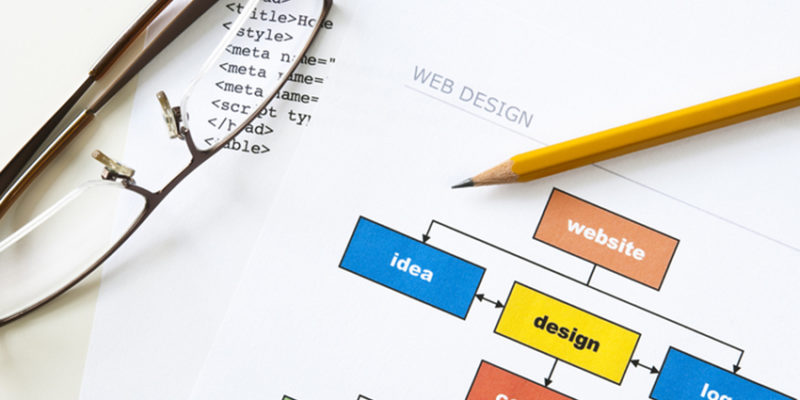
Whether you want to have a B2B or B2C website, both should drive quantifiable business results. Indeed, the website design choices, which position them to perform, vary greatly!
Just like how services, products, and objectives of organizations differ from one another, the needs of the website design they use to promote their business and generate revenue also change. All too often, companies fail to recognize this basic fact and apply the website design techniques of a popular B2C site to their B2B website.

Indeed, business-to-business (B2B) websites have a lot in common with business-to-consumer (B2C) sites. Both of them need to create a clear information structure, include compelling content, and provide details of products and services. They need to understand and provide the target audience what they care about while having an interactive and comprehensive design.
In essence, almost all the standard user experience guidelines apply both to B2C and B2B sites. You can find so many best practices for web design, all over the web, but there is a difference in applying these practices to a WordPress site. This does not mean that we should not follow the best practices as they are considered ‘best’ for a reason.
Based on the target audience, the easiest way to incorporate this approach to your web design is through industry segmentation or by considering B2B and B2C marketing and sales, differently.
This line of difference drawn between B2C and B2B marketing and web design can often be too fuzzy. Still, it is imperative to understand the not-so-subtle and subtle differences. So, before we dig deeper into the differences between B2C and B2B design, let us first take a look at what makes B2C unique from B2B.
B2B vs. B2C
To start, the sale cycle of both of these businesses type is different. Typically, B2B sales take longer to nurture. On the other hand, B2C sales, on the whole, tend to be more straightforward as well as less complex. This is particularly true when it comes to services. Not to mention, due to more complex and longer B2B sales process, it demands significant investment for relationship building.
So, without further ado, let’s talk about the major differences between a B2C and B2B web design while establishing the key factors that influence such differences.
Major Differences Between B2B and B2C Web Design Requirements
Let’s find out how such distinctions manifest themselves in B2B and B2C web design.
1. The Target Audience
Your target audience is solely responsible for both the purchase and decision-making. When it comes to B2B websites, the customer needs to wait for many individuals first to assess the offered product or service and then come to a decision.
Your target audience is solely responsible for both the purchase and decision-making. When it comes to B2B websites, the customer needs to wait for many individuals first to assess the offered product or service and then come to a decision.
Your target audience is the most obvious reason to consider different web designs. Design and marketing teams put a lot of time and effort into defining your buyers’ personas for your B2C website. A well-designed B2C site is often personalized for the individual customer by their personas and buyers’ browsing and purchasing habits.
However, if we look at the vast majority of business-to-consumer purchase cycles, you target the same person throughout the purchase funnel. Well, this is not the case for a B2B site. These web designs must cater to quite different personas that may all get engaged in a single lead. The usual target audience is the group of 4 – 5 people in a single organization. This approach often complicates the website’s information architecture as your site must address a range of pain points.
B2B sites aren’t superficial hubs that would instantly sell services or merchandise. Still, they have to be robust portals containing complete specifications, descriptions, and research so that a buyer can come to a final decision.
2.Buying Cycles
When it comes to B2B companies, the sale cycle is much longer than it is for B2C. When you sell straight to the consumer, this can be done in just one browsing session of the website. For instance, a person searching for a technician might prefer doing the following in a 20-minutes time.
- Browse through a couple of relevant websites
- Read customer reviews
- Revisit one of the site to look out for quality reviews
- Check out the entire website segments
- Make a call on the given number
- Book the appointment for any feasible day
On the contrary, if we look at the B2B audience, a company might be looking to purchase a new piece of manufacturing tool and to get the best equipment. They may not only take months but even years while doing the following:
- Arrange an internal staff meeting to discuss the need for the new equipment
- Assign some entry-level staff member to perform the initial research
- The assigned employee will browse around 6 – 7 potential vendors
- The employee will ascertain the pros and cons of each vendor
- He/she will send options to the buyer or manager in the relevant department
- Buyer or manager will vet the given websites and pick out the top 3
- The assigned staff member will fill out the content form on the chosen sites
- Initiation of a sale process that would take months to determine delivery and installation details, purchase price, training, etc
- Final closure of the sale
Just by looking at both the buying cycles in a graphic form, it is evident that building a site that adequately addresses the second scenario instead of the first one, needs a lot more unique strategies. Since pricing on a B2B website is not usually visible, customers vet potential partners for quality, trust, and expertise.
3. Design
When we say design, we refer to the term in an inclusive sense. For now, we will use this term to see to the feel of a site and to explain the general aesthetic. If we talk about B2B websites, most of the companies are usually SaaS companies. Now you must have an idea about the style used to design such kind of sites. These websites have:
- Minimal design
- Safe choices regarding imagery and typography
- Bold swatches of contrasting colors but not too outlandish
Overall, a B2B site design gives out a very buttoned-up image. As soon as you visit such sites, you can tell the kind of businesses they are based on including their target market. To get a better understanding, have a look at the GreenGeeks company design.
For the most part, the site is very conservatively designed. The top banner has the black background along with bright green text that stands out. No doubt, they aim to attract a very particular kind of eco-conscious buyer.
When it comes to B2C, this isn’t the case. However, often there are some conservative brands with a website design similar to a B2B company. Otherwise, these businesses’ websites tend to be more playful with design, as long as it fully aligns with the overall look of the brand.
These websites usually have a design that incorporates:
- Large and eye-catching imagery, with minimal content/text laid around it or atop
- Spacing, typography, and layout that may break the rules but without compromising the readability
- Good color contrasts and movement play a significant role in directing different visitors to places they should go, creating a sense of urgency
Browse through some of the B2C websites, and you will find them littered with multiple shades of color along with capped headers that easily direct the visitors to the place they need to go.
4. Fixed Cost vs. Custom Pricing
Another significant difference between a B2C and B2B website is regarding pricing. Considering B2C environment, listed pricing is often very straightforward. Any customer who wants to purchase a new computer visits the website and browse through the number of machines, clearly stated with a fixed price.
On the other hand, in many B2B companies, prices are usually negotiable and customized. When it comes to B2B, a corporate purchase may be interested, and that may include system integration as well as technical support.
But the question remains; how these differences in pricing affect the web design? Well, any website that advertises custom-pricing must pay attention to:
- Content that would help address the value, i.e. high quality, low cost, worth it, etc.
- A promise of timely turnaround – let customers know that you will get back to them at the earliest to answer all of the questions they might have
- Keeping contact and lead generation forms precise and short – it must not include items that a sales team may ask during the follow-up stage
- Using calculators – if possible and if the custom pricing is merely a formula based on a few inputs like quantity and location, you can offer a quote by using a very interactive calculator.
5. Call-to-Actions – CTAs
In the absence of a call-to-action button, it can be quite challenging to guide the visitors to conversion. However, the type of CTA you need to have on your website depends on your business type, i.e. B2C or B2B.
Since there is no instant buying decision for a B2B customer, the websites of these organizations must go with a variety of CTAs. This will help to reach prospects at various points throughout the journey like if they are learning about your product, exploring pricing options, conducting more in-depth research, reaching out a demo or so on.
A B2B site must give a range of options to help customers to make contact. This can quickly be done by incorporating a robust system of CTAs. You can place these CTAs in different areas of the website. Apart from just the homepage, you can also put them lower on the page. For instance, directly after some educational and relevant section that would help educate the visitors.
However, in the case of B2C websites, you cannot waste that much time and space to add a variety of CTAs. The consumers of B2C companies precisely know what they are looking for, where is it located on the site. They already trust your business and ready to make a purchase. So avoid giving them a complete maze of CTAs along with pages to work their way through.
All you need to offer is an immediate action, such as ‘Add to Cart.’ Also, keep using bold-colored content and above-the-fold-placed CTAs to direct the visitor towards checkout easily and finally to the sale.
The Final Words
There could be many ways in which a B2C and B2B website may differ including support delivery and content marketing, but these aren’t the things to worry about. All you need is a B2C and B2B mindset. You need to focus on the most visible and essential elements that are majorly influenced by the target audience preferences. This will help in planning the WP website effectively.
To mention, a B2B and B2C website design has the following items in common:
- Clear language
- Responsive design
- Simplified and intuitive navigation
- Web security
- Performance optimization
Don’t mistake the web design differences with the process. The process will not differ a lot with regards to project milestones, phases, prototyping and wire framing, quality assurance (QA) and others. The framework of the process doesn’t need to be changed. The sole difference is how you approach the designing of different elements.
The change in design is not the complete revamp of the workflow. It has more to do with design applications and mindset than anything else.
Do you have any other valuable information about B2C and B2B web design? If yes, don’t forget to share it with us in the comment section below.





